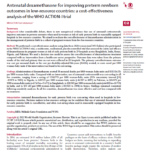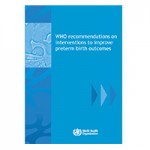Administering antenatal corticosteroids (ACS) to mothers at risk of premature birth accelerates fetal lung development and reduces risk of infant respiratory distress syndrome, one of the most common life-threatening complications of prematurity. In addition, ACS administration decreases the risk of brain hemorrhage and serious prematurity complications such as necrotizing enterocolitis (NEC), a life-threatening intestinal infection.
In high-resource countries, the standard of care for more than two decades has been administration of ACS in cases where a woman is imminently likely to deliver prematurely (less than 34 weeks gestation). ACS use in low- and middle-income countries (LMICs) has been a slower process, in part due to limited evidence regarding safe and effective ACS administration. In many LMIC settings, accurate gestational age assessment is often lacking, as is the quality perinatal care required to prevent and manage preterm complications. Recent research evidence from a multi-country randomized controlled trial (ACTION) demonstrated significant reductions of neonatal deaths and stillbirths, showing the benefit of ACS in LMICs.
36
Percent of neonatal deaths due to preterm birth complications globally (2019)
10.6
The rate of preterm births globally (2014)
1972
The year that antenatal corticosteriods (ACS) were first used to accelerate fetal lung maturation in threatened preterm birth
All data on this page represents the most recent data available. Please visit our Newborn Numbers page and download the Excel spreadsheet to explore the data further.
Current Guidance
WHO is currently updating global ACS recommendations based on systematic review of evidence, including the ACTION trial. Until the guidelines are updated, ACS therapy should continue to be used only when certain conditions can be met: when gestational age can be accurately determined, when preterm birth is considered imminent, when there is no evidence of maternal infection, and when adequate newborn and delivery care is available, including care for complications, infection management, feeding support, thermal care, and access to respiratory support. For now, ACS therapy may be safely and effectively administered in LMICs when these conditions can be met. Dexamethasone is the most commonly available antenatal corticosteroid in LMICs. WHO currently includes dexamethasone in its Model List of Essential Medicines, and it is included on the Essential Medicines lists of many countries worldwide.
It is crucial that health systems and providers prioritize proper training and quality of care to increase survival and health outcomes for preterm newborns and their mothers, and this quality care includes appropriate use of ACS for threatened imminent preterm delivery; for more information, see the preterm birth complications page.
Key Resources
- WHO recommendations on antenatal corticosteroids for improving preterm birth outcomes. (2022)
- Antenatal corticosteroids for accelerating fetal lung maturation for women at risk of preterm birth. Cochrane Database of Systematic Reviews. (2017)
- Reducing neonatal mortality and respiratory distress syndrome associated with preterm birth: a scoping review on the impact of antenatal corticosteroids in low- and middle-income countries (2021)
- Antenatal Dexamethasone for Early Preterm Birth in Low-Resource Countries (2020)
- Video – Can antenatal corticosteroids prevent preterm infant death and morbidity in low-resource settings? (2022)
- Steroids boost survival of preterm babies in low-resource settings, new study finds (2020)








